Analysis of Phase-Specific Strain Pole Figures for Duplex Steels under Elasto-Plastic Uniaxial Tension—Experiment vs. EPSC Modelling
Abstract
:1. Introduction
2. Experiment
3. Elasto-Plastic Self-Consistent Model
4. Using the EPSC Model to Describe the Strain Pole Figure Experiment
5. Results and Discussion
5.1. Experimental Results
5.2. Validation of EPSC Modelling—Elastic Material Behaviour
5.3. Results of EPSC Modelling—Elasto-Plastic Material Behaviour
5.4. Comparison of Numerical and Experimental Results
6. Conclusions
- The results show that, for the duplex stainless steel, plastic anisotropy effects can be determined for its two phases, austenite and ferrite, which are triggered by existing phase-specific crystallographic textures. As expected, these effects increase with increasing degrees of deformation.
- Failure to take these effects into account sometimes leads to severely incorrect (residual) stress evaluations.
- The lattice planes that are recommended in the literature for residual stress analyses are also shown to be relatively insensitive to plastic anisotropy effects on the existing material state of the duplex stainless steel X2CrNiMoN22-5-3. The associated lattice strain vs. distributions are still sufficiently linear even at high degrees of deformation.
- The proposed EPSC model, in which the austenite and ferrite phases were coupled accordingly to represent the material behaviour of the duplex stainless steel, appears fundamentally suitable to describe the material’s {hkl}-specific deformation behaviour.
- However, at relatively high strain deformations of 10%, there are sometimes clear deviations from the neutronographic results. An improvement is planned here by, among other things, further expanding the model to include additional strengthening mechanisms, such as grain boundary strengthening.
Author Contributions
Funding
Data Availability Statement
Acknowledgments
Conflicts of Interest
References
- Moura, V.S.; Lima, L.D.; Pardal, J.M.; Kina, A.Y.; Corte, R.; Tavares, S. Influence of microstructure on the corrosion resistance of the duplex stainless steel UNS S31803. Mater. Charact. 2008, 59, 1127–1132. [Google Scholar] [CrossRef]
- Calderón-Uríszar-Aldaca, I.; Briz, E.; Matanza, A.; Martin, U.; Bastidas, D.M. Corrosion Fatigue Numerical Model for Austenitic and Lean-Duplex Stainless-Steel Rebars Exposed to Marine Environments. Metals 2020, 10, 1217. [Google Scholar] [CrossRef]
- Johansson, J. Residual Stresses and Fatigue in a Duplex Stainless Steel. Ph.D. Thesis, Linkoeping Studies in Science and Technology, Linköping, Sweden, 1999. [Google Scholar]
- TMR Stainless. Practical Guidelines for the Fabrication of Duplex Stainless Steels, 3rd ed.; International Molybdenum: London, UK, 2014; ISBN 978-1-907470-09-7. [Google Scholar]
- Tang, J.; Yang, X.; Wang, Y.; Wang, H.; Xiao, Y.; Apreutesei, M.; Nie, Z.; Normand, B. Corrosion Behavior of 2205 Duplex Stainless Steels in HCl Solution Containing Sulfide. Metals 2019, 9, 294. [Google Scholar] [CrossRef]
- Kumar, A.; Khatirkar, R.K.; Chalapathi, D.; Kumar, G.; Suwas, S. Microstructure and Texture Development during Cold Rolling in UNS S32205 and UNS S32760 Duplex Stainless Steels. Metall. Mater. Trans. A 2017, 48, 2349–2362. [Google Scholar] [CrossRef]
- Zettl, B.; Schmid, H.; Pulvermacher, S.; Dyck, A.; Böhlke, T.; Gibmeier, J.; Merklein, M. Improvement of process control in sheet metal forming by considering the gradual properties of the initial sheet metal. J. Strain Anal. Eng. Des. 2023. [Google Scholar] [CrossRef]
- Simon, N.; Erdle, H.; Walzer, S.; Gibmeier, J.; Böhlke, T.; Liewald, M. Residual stresses in deep-drawn cups made of duplex stainless steel X2CrNiN23-4. Forsch Ingenieurwes 2021, 85, 795–806. [Google Scholar] [CrossRef]
- Chalapathi, D.; Sivaprasad, P.V.; Chai, G.; Kanjarla, A.K. Anisotropic work hardening behaviour in duplex stainless steel under uni-axial loading: Interplay between phase morphology and crystallographic texture. Mater. Sci. Eng. A 2022, 849, 143418. [Google Scholar] [CrossRef]
- Chalapathi, D.; Bhaskar, L.K.; Sivaprasad, P.V.; Chai, G.; Kumar, R.; Kanjarla, A.K. Biaxial deformation behaviour of duplex stainless steels: Experiments and crystal plasticity based stress predictions. Mater. Sci. Eng. A 2023, 864, 144597. [Google Scholar] [CrossRef]
- Pulvermacher, S.; Bücker, T.; Šaroun, J.; Rebelo-Kornmeier, J.; Hofmann, M.; Gibmeier, J. Neutron and X-ray Diffraction Analysis of Macro and Phase-Specific Micro Residual Stresses in Deep Rolled Duplex Stainless Steels. Materials 2021, 14, 1854. [Google Scholar] [CrossRef]
- Hutchings, M.T.; Withers, P.J.; Holden, T.M.; Lorentzen, T. Introduction to the Characterization of Residual Stress by Neutron Diffraction, 1st ed.; CRC Press Taylor & Francis Group: Boca Raton, FL, USA, 2005; ISBN 0-415-31000-8. [Google Scholar]
- Allen, A.J.; Bourke, M.; David, W.I.F.; Dawes, S.; Hutchings, M.T.; Krawitz, A.D.; Windsor, C.G. Effects of Elastic Anisotropy on the Lattice Strains in Polycrystalline Metals and Composites Measured by Neutron Diffraction. In International Conference on Residual Stresses: ICRS2; Beck, G., Denis, S., Simon, A., Eds.; Springer: Dordrecht, The Netherlands, 1989; pp. 78–83. ISBN 978-94-010-7007-2. [Google Scholar]
- Clausen, B.; Brown, D.; Tomé, C.; Balogh, L.; Vogel, S. Engineering related neutron diffraction measurements probing strains, texture and microstructure. In Proceedings of the 31st Riso International Symposium on Materials Science. Technical University of Denmark, Riso National Laboratory for Sustanaible Energy, Roskilde, Denmark, 6–10 September 2010. [Google Scholar]
- Clausen, B.; Lorentzen, T.; Bourke, M.A.; Daymond, M.R. Lattice strain evolution during uniaxial tensile loading of stainless steel. Mater. Sci. Eng. A 1999, 259, 17–24. [Google Scholar] [CrossRef]
- Daymond, M.R.; Tomé, C.N.; Bourke, M. Measured and predicted intergranular strains in textured austenitic steel. Acta Mater. 2000, 48, 553–564. [Google Scholar] [CrossRef]
- Pulvermacher, S.; Pirling, T.; Cabeza, S.; Zuern, M.G.; Hofmann, M.; Gibmeier, J. Neutronographic Analysis of Load Partitioning and Micro Residual Stress Development in Duplex Stainless Steels. Crystals 2022, 12, 1378. [Google Scholar] [CrossRef]
- Dye, D.; Stone, H.J.; Reed, R.C. Intergranular and interphase microstresses. Curr. Opin. Solid State Mater. Sci. 2001, 5, 31–37. [Google Scholar] [CrossRef]
- ISO 21432:2020; Non-Destructive Testing—Standard Test Method for Determining Residual Stresses by Neutron Diffraction. DIN Deutsches Institut für Normung e. V., DIN German Institute for Standardization, Beuth Verlag GmbH: Berlin, Germany, 2020.
- Holden, T.M.; Clarke, A.P.; Holt, R.A. Neutron diffraction measurements of intergranular strains in MONEL-400. Metall. Mater. Trans. A 1997, 28, 2565–2576. [Google Scholar] [CrossRef]
- Clausen, B. Characterisation of Polycrystal Deformation by Numerical Modeling and Neutron Diffraction Measurements; Riso National Laboratory: Roskilde, Denmark, 1997. [Google Scholar]
- Pang, J.; Holden, T.; Mason, T. In situ generation of intergranular strains in an Al7050 alloy. Acta Mater. 1998, 46, 1503–1518. [Google Scholar] [CrossRef]
- Pang, J.W.L.; Holden, T.M.; Mason, T.E. The development of intergranular strains in a high-strength steel. J. Strain Anal. Eng. Des. 1998, 33, 373–383. [Google Scholar] [CrossRef]
- Daymond, M.R.; Priesmeyer, H.G. Elastoplastic deformation of ferritic steel and cementite studied by neutron diffraction and self-consistent modelling. Acta Mater. 2002, 50, 1613–1626. [Google Scholar] [CrossRef]
- Gloaguen, D.; Girault, B.; Fajoui, J.; Klosek, V.; Moya, M.J. Lattice Strain Pole Figures Analysis in Titanium during Uniaxial Deformation. Mater. Sci. Forum 2017, 905, 74–80. [Google Scholar] [CrossRef]
- Larsson, C.; Clausen, B.; Holden, T.M.; Bourke, M. Measurements and predictions of strain pole figures for uniaxially compressed stainless steel. Scr. Mater. 2004, 51, 571–575. [Google Scholar] [CrossRef]
- Miller, M.P.; Bernier, J.V.; Park, J.-S.; Kazimirov, A. Experimental measurement of lattice strain pole figures using synchrotron x rays. Rev. Sci. Instrum. 2005, 76, 113903. [Google Scholar] [CrossRef]
- Eigenmann, B.; Scholtes, B.; Macherauch, E. Principles and applications of X-ray stress determination in ceramics and ceramic-metal composites. Mater. Werkst. 1989, 20, 314–325. [Google Scholar] [CrossRef]
- Clausen, B.; Tomé, C.N.; Brown, D.W.; Agnew, S.R. Reorientation and stress relaxation due to twinning: Modeling and experimental characterization for Mg. Acta Mater. 2008, 56, 2456–2468. [Google Scholar] [CrossRef]
- Clausen, B.; Lorentzen, T.; Leffers, T. Self-consistent modelling of the plastic deformation of f.c.c. polycrystals and its implications for diffraction measurements of internal stresses. Acta Mater. 1998, 46, 3087–3098. [Google Scholar] [CrossRef]
- Muránsky, O.; Barnett, M.R.; Luzin, V.; Vogel, S. On the correlation between deformation twinning and Lüders-like deformation in an extruded Mg alloy: In situ neutron diffraction and EPSC.4 modelling. Mater. Sci. Eng. A 2010, 527, 1383–1394. [Google Scholar] [CrossRef]
- Li, H.; Cai, W.; Fan, Z.; Huang, X.; Wang, Y.; Gong, J.; Chen, B.; Sun, G.; Wang, H.; Li, J.; et al. Compression deformation behavior of Zircaloy-4 alloy changing with activated twinning type at ambient temperature: Experiment and modeling. J. Appl. Crystallogr. 2016, 49, 987–996. [Google Scholar] [CrossRef]
- Baczmański, A. Elastoplastic properties of duplex steel determined using neutron diffraction and self-consistent model. Acta Mater. 2004, 52, 1133–1142. [Google Scholar] [CrossRef]
- Baczmański, A.; Levy-Tubiana, R.; Fitzpatrick, M.E.; Lodini, A. Elastoplastic deformation of Al/SiCp metal–matrix composite studied by self-consistent modelling and neutron diffraction. Acta Mater. 2004, 52, 1565–1577. [Google Scholar] [CrossRef]
- Dakhlaoui, R.; Baczmański, A.; Braham, C.; Wroński, S.; Wierzbanowski, K.; Oliver, E.C. Effect of residual stresses on individual phase mechanical properties of austeno-ferritic duplex stainless steel. Acta Mater. 2006, 54, 5027–5039. [Google Scholar] [CrossRef]
- Pirling, T.; Bruno, G.; Withers, P.J. SALSA—A new instrument for strain imaging in engineering materials and components. Mater. Sci. Eng. A 2006, 437, 139–144. [Google Scholar] [CrossRef]
- DIN EN 10027-2:2015-07; Bezeichnungssysteme für Stähle_- Teil_2: Nummernsystem; Deutsche Fassung. Beuth Verlag GmbH: Berlin, Germany, 2015.
- ThyssenKrupp Materials Europe, Technischer Verkauf/Qualitätsmanagement. Werkstoffblatt TK 1.4462 (X2CrNiMoN22-5-3), 45313 Essen. 03/2006.
- DIN EN 10088-3:2014-12; Nichtrostende Stähle_- Teil_3: Technische Lieferbedingungen für Halbzeug, Stäbe, Walzdraht, Gezogenen Draht, Profile und Blankstahlerzeugnisse aus Korrosionsbeständigen Stählen für allgemeine Verwendung. Deutsche Fassung; Beuth Verlag GmbH: Berlin, Germany, 2014.
- Bachmann, F.; Hielscher, R.; Schaeben, H. Texture Analysis with MTEX—Free and Open Source Software Toolbox. Solid State Phenom. 2010, 160, 63–68. [Google Scholar] [CrossRef]
- Richard, D.; Ferrand, M.; Kearley, G.J. Analysis and visualisation of neutron-scattering data. J. Neutron Res. 1996, 4, 33–39. [Google Scholar] [CrossRef]
- Withers; Preuss, P.J.M.; Steuwerb, A.; Pang, J.W.L. Methods for obtaining the strain-free lattice parameter when using diffraction to determine residual stress. Appl. Crystallogr. 2007, 40, 891–904. [Google Scholar] [CrossRef]
- Kehrer, L.; Wood, J.T.; Böhlke, T. Mean-Field Homogenization of Thermoelastic Material Properties of a Long Fiber-Reinforced Thermoset and Experimental Investigation. J. Compos. Mater. 2020, 54, 3777–3799. [Google Scholar] [CrossRef]
- Willis, J.R. Variational and Related Methods for the Overall Properties of Composites. In Advances in Applied Mechanics; Yih, C.-S., Ed.; Academic Press: New York, NY, USA, 1981; pp. 1–78. ISBN 9780120020218. [Google Scholar]
- Eshelby, J.D. The determination of the elastic field of an ellipsoidal inclusion, and related problems. Proc. R. Soc. Lond. A 1957, 241, 376–396. [Google Scholar] [CrossRef]
- Neil, C.J.; Wollmershauser, J.A.; Clausen, B.; Tomé, C.N.; Agnew, S.R. Modeling lattice strain evolution at finite strains and experimental verification for copper and stainless steel using in situ neutron diffraction. Int. J. Plast. 2010, 26, 1772–1791. [Google Scholar] [CrossRef]
- Turner, P.A.; Tomé, C.N. A study of residual stresses in Zircaloy-2 with rod texture. Acta Metall. Mater. 1994, 42, 4143–4153. [Google Scholar] [CrossRef]
- Han, Y. Weiterentwicklung eines selbst-konsistenten Materialmodells zur Beschreibung des phasenspezifischen, elasto-plastischen Verhaltens grob mehrphasiger Werkstoffe. Master’s Thesis, KIT, IAM-WK, Department “Structur and Stress Analysis”, Karlsruhe, Germany, 2020. [Google Scholar]
- Tomé, C.N.; Oliver, E.C.; Wollmershauser, J.A. EPSC4 Manual; Los Alamos National Laboratory: Los Alamo, NM, USA, 2010. [Google Scholar]
- Loebich, F. Bestimmung der Verbund-REK des Werkstoffs 1.4462 und Implementierung eines Ansatzes zur Kopplung Mehrerer Phasen in ein bestehendes EPSC-Modell; Seminararbeit/Term paper, KIT, IAM-WK, Department “Structur and Stress Analysis”, Engelbert-Arnold-Straße 4, 76131 Karlsruhe, Germany. 2022. [Google Scholar]
- Beyerlein, I.J.; Tomé, C.N. A dislocation-based constitutive law for pure Zr including temperature effects. Int. J. Plast. 2008, 24, 867–895. [Google Scholar] [CrossRef]
- Raghunathan, S.L.; Stapleton, A.M.; Dashwood, R.J.; Jackson, M.; Dye, D. Micromechanics of Ti–10V–2Fe–3Al: In situ synchrotron characterisation and modelling. Acta Mater. 2007, 55, 6861–6872. [Google Scholar] [CrossRef]
- Stapleton, A.M.; Raghunathan, S.L.; Bantounas, I.; Stone, H.J.; Lindley, T.C.; Dye, D. Evolution of lattice strain in Ti–6Al–4V during tensile loading at room temperature. Acta Mater. 2008, 56, 6186–6196. [Google Scholar] [CrossRef]
- Warwick, J.; Coakley, J.; Raghunathan, S.L.; Talling, R.J.; Dye, D. Effect of texture on load partitioning in Ti-6Al-4V. Acta Mater. 2012, 60, 4117–4127. [Google Scholar] [CrossRef]
- Shi, R.; Li, G.; Nie, Z.; Fan, Q. Determination of the single-phase constitutive relations of α/β dual phase TC6 titanium alloy. Mater. Sci. Eng. A 2016, 675, 138–146. [Google Scholar] [CrossRef]
- Hounkpati, V.; Fréour, S.; Gloaguen, D.; Legrand, V.; Kelleher, J.; Kockelmann, W.; Kabra, S. In situ neutron measurements and modelling of the intergranular strains in the near-β titanium alloy Ti-β21S. Acta Mater. 2016, 109, 341–352. [Google Scholar] [CrossRef]
- Dvorak, G. Micromechanics of Composite Materials; Springer: Dordrecht, The Netherlands, 2013. [Google Scholar]
- Kachanov, M.; Sevostianov, I. Micromechanics of Materials, with Applications; Springer International Publishing: Cham, Switzerland, 2018. [Google Scholar]
- Liu, H. Advancement of a Self-Consistent Material Model for the Numerical Simulation of the Phase-Specific, Elasto-Plastic Behaviour of Duplex Steels. Master’s Thesis, KIT, IAM-WK, Department “Structur and Stress Analysis”, Karlsruhe, Germany, 2021. [Google Scholar]
- Du, C.; Maresca, F.; Geers, M.; Hoefnagels, J. Ferrite slip system activation investigated by uniaxial micro-tensile tests and simulations. Acta Mater. 2018, 146, 314–327. [Google Scholar] [CrossRef]
- Dakhlaoui, R.; Baczmański, A.; Braham, C.; Wroński, S.; Wierzbanowski, K.; Oliver, E.C. Neutron Diffraction Study of Duplex Stainless Steel during Loading at 200 °C. Mater. Sci. Forum 2008, 571, 175–180. [Google Scholar] [CrossRef]
- Gibmeier, J.; Cabeza, S.; Hofmann, M.; Pirling, T.; Pulvermacher, S.; Rebelo Kornmeier, J. In-Situ Determination of Grain-Orientation-Dependent Intergranular Strain during Defined Uniaxial Loading of Duplex Stainless Steel; Institut Laue-Langevin: Grenoble, France, 2021. [Google Scholar] [CrossRef]
- Dakhlaoui, R.; Braham, C.; Baczmański, A. Mechanical properties of phases in austeno-ferritic duplex stainless steel—Surface stresses studied by X-ray diffraction. Mater. Sci. Eng. A 2007, 444, 6–17. [Google Scholar] [CrossRef]
- Behnken, H.; Hauk, V. Berechnung der röntgenographischen Spannungsfaktoren texturierter Werkstoffe-Vergleich mit experimentellen Ergebnissen. Int. J. Mater. Res. 1991, 82, 154–158. [Google Scholar] [CrossRef]
- Behnken, H. Mikrospannungen in Vielkristallinen und Heterogenen Werkstoffen; Shaker: Aachen, Germany, 2003; ISBN 3832213848. [Google Scholar]
- Simon, N.; Schell, N.; Gibmeier, J. On the Oscillating Course of dhkl−sin2ψ Plots for Plastically Deformed, Cold-Rolled Ferritic and Duplex Stainless Steel Sheets. Crystals 2023, 13, 419. [Google Scholar] [CrossRef]
- Daymond, M.R. The determination of a continuum mechanics equivalent elastic strain from the analysis of multiple diffraction peaks. J. Appl. Phys. 2004, 96, 4263–4272. [Google Scholar] [CrossRef]
- Simon, N.; Krause, M.; Heinemann, P.; Erdle, H.; Böhlke, T.; Gibmeier, J. Phase-Specific Strain Hardening and Load Partitioning of Cold Rolled Duplex Stainless Steel X2CrNiN23-4. Crystals 2020, 10, 976. [Google Scholar] [CrossRef]
- Gnäupel-Herold, T. ISODEC: Software for calculating diffraction elastic constants. J. Appl. Crystallogr. 2012, 45, 573–574. [Google Scholar] [CrossRef]
- Gnäupel-Herold, T. A software for diffraction stress factor calculations for textured materials. Powder Diffr. 2012, 27, 114–116. [Google Scholar] [CrossRef]
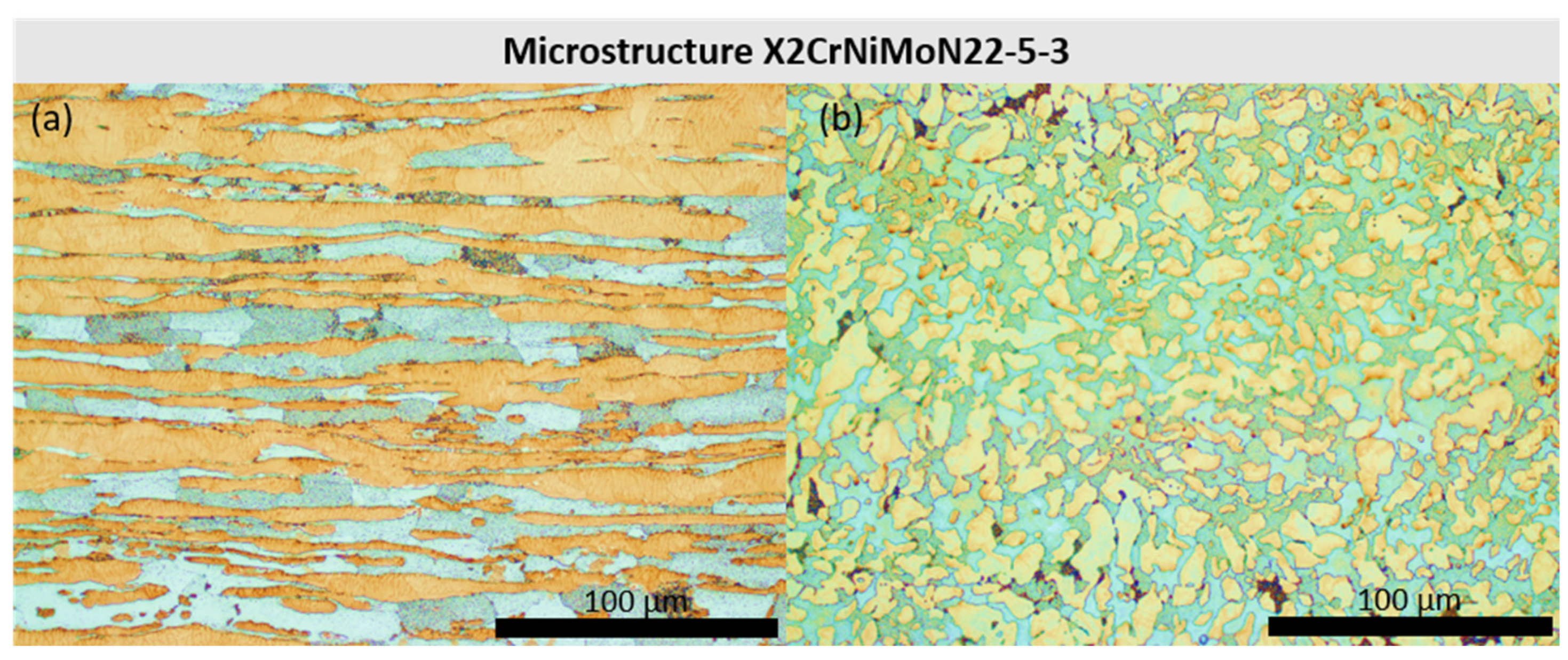



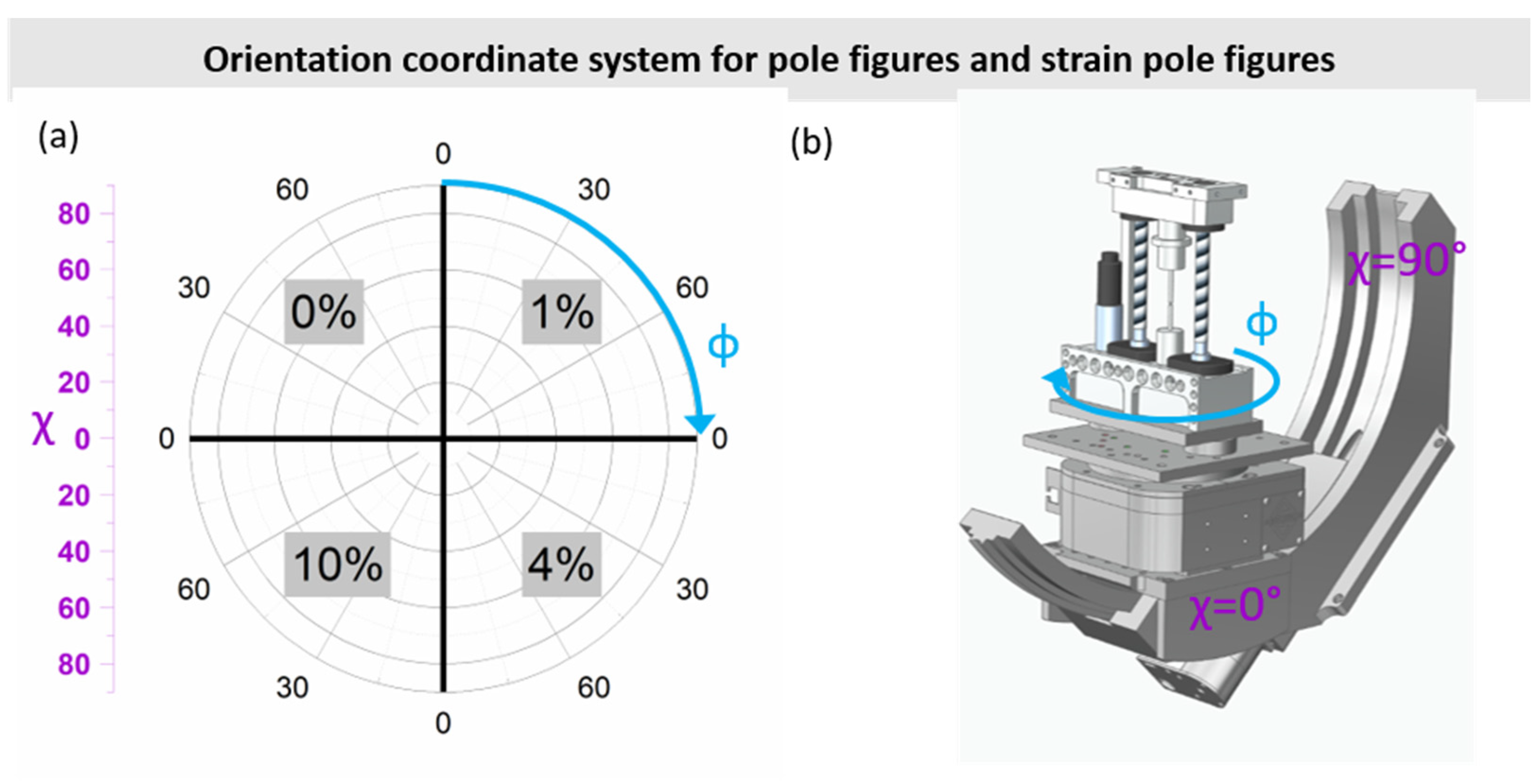
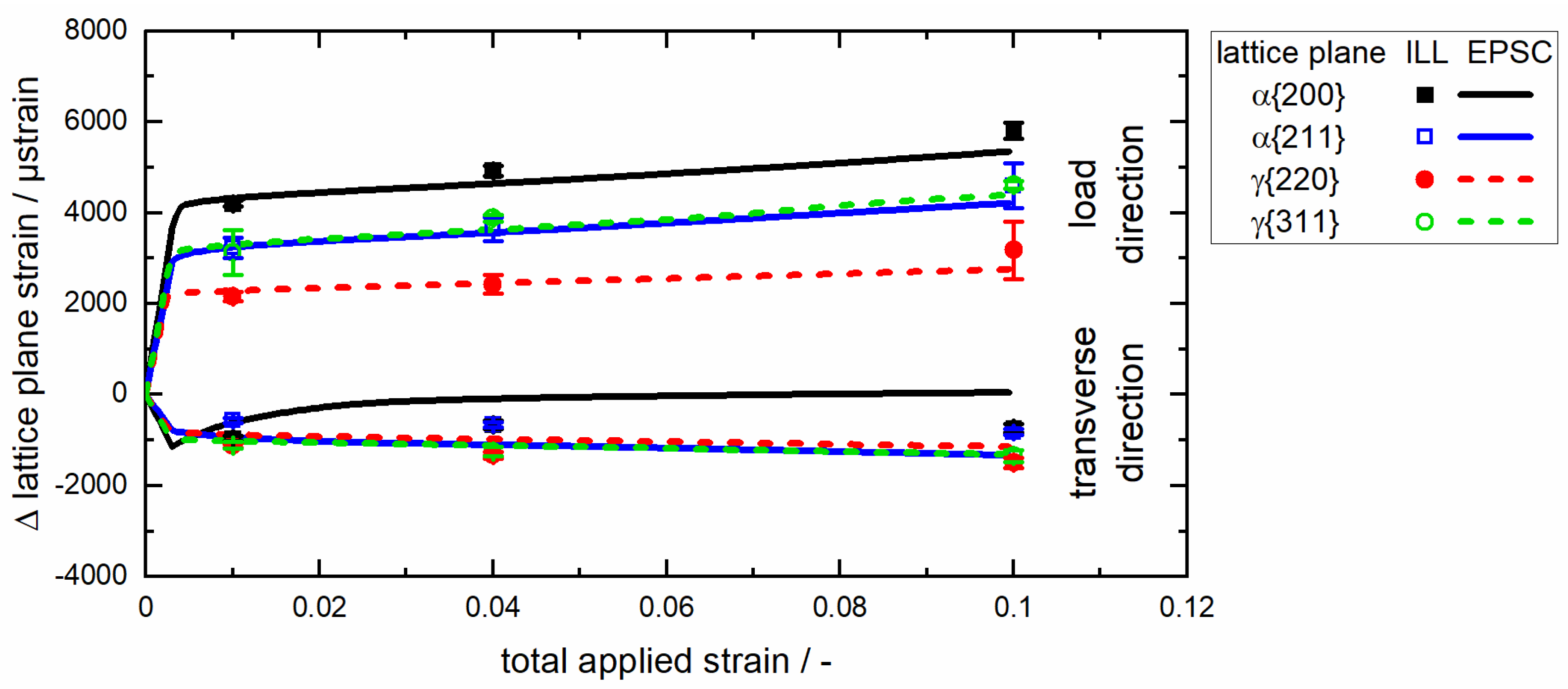

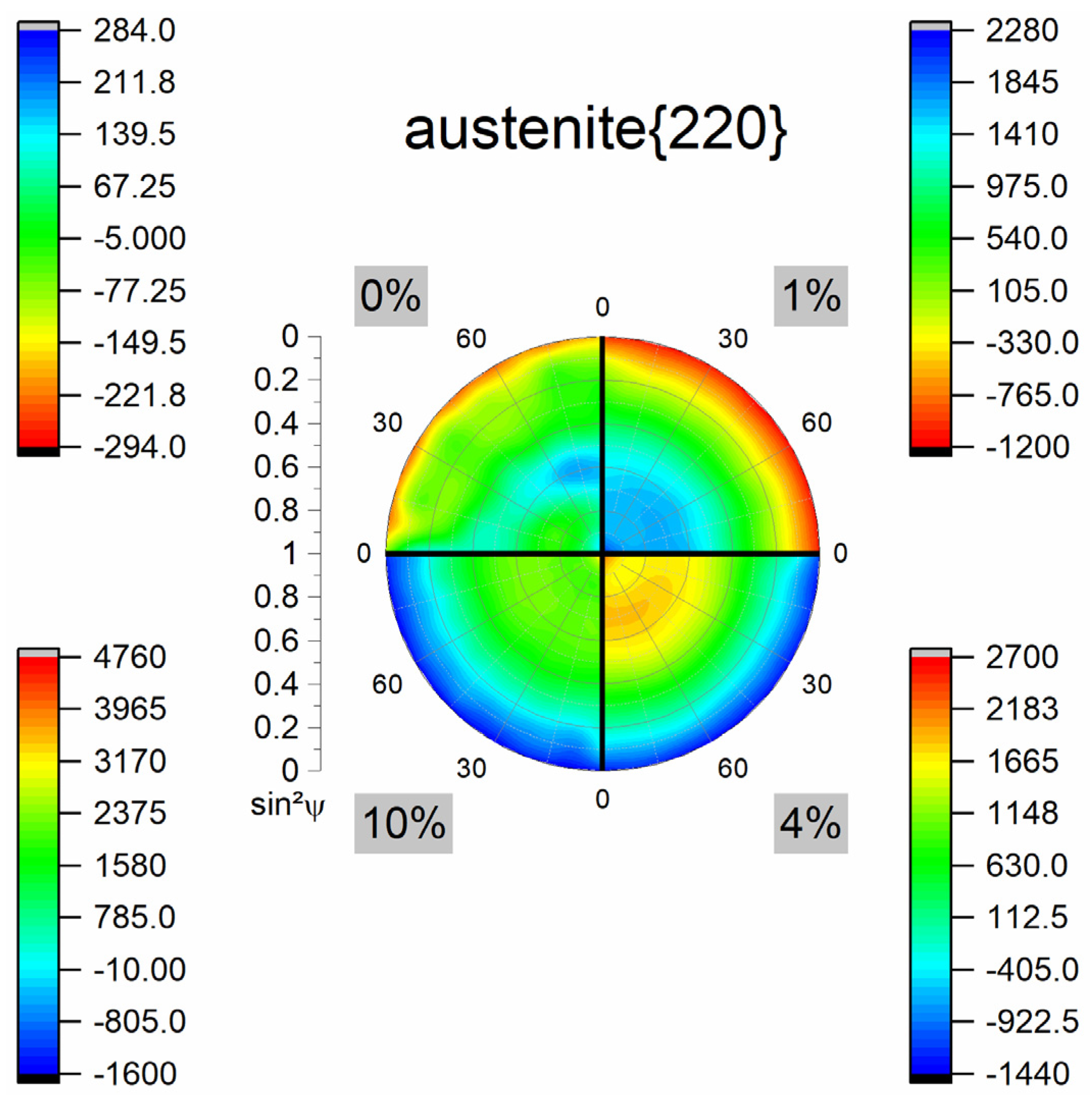
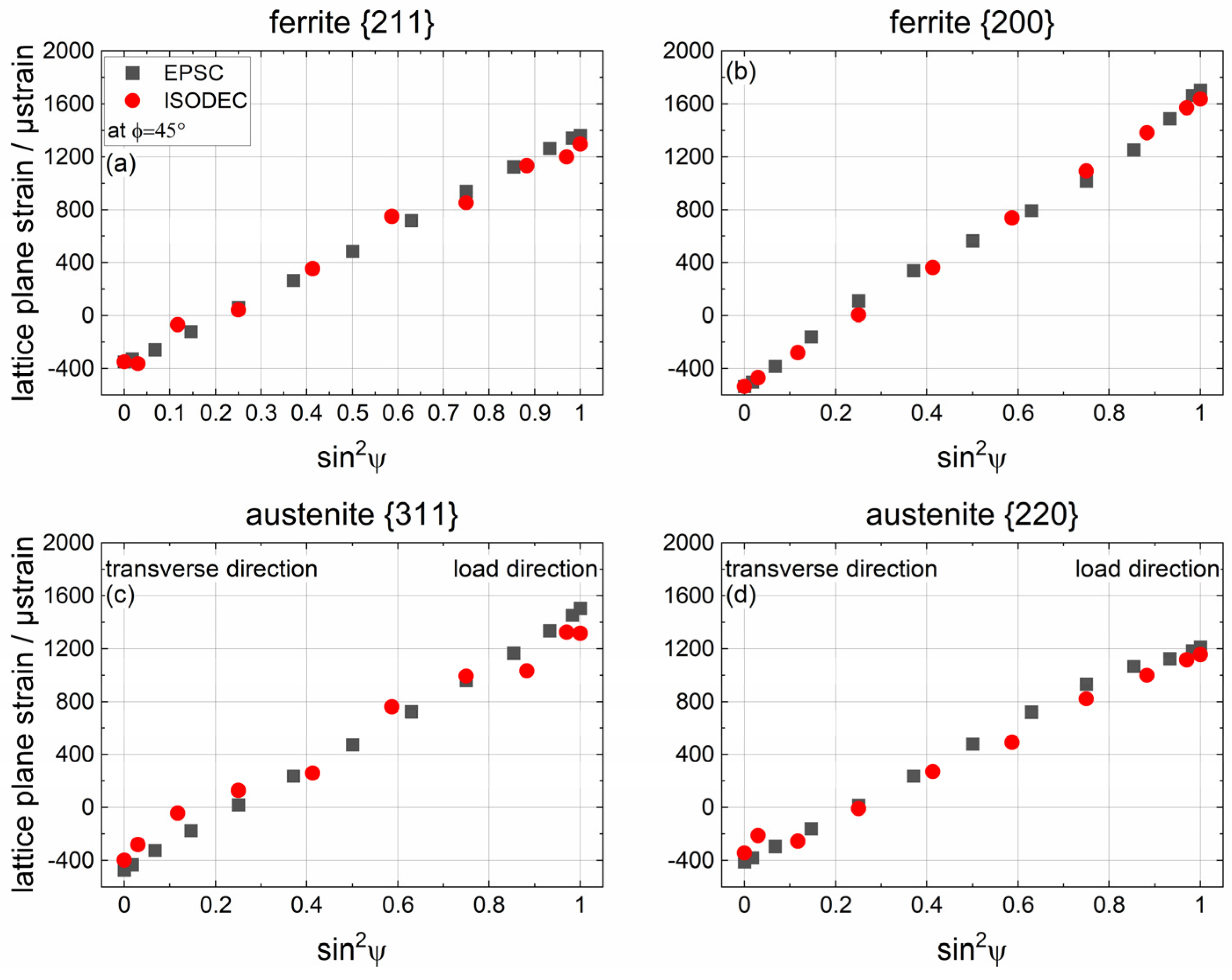
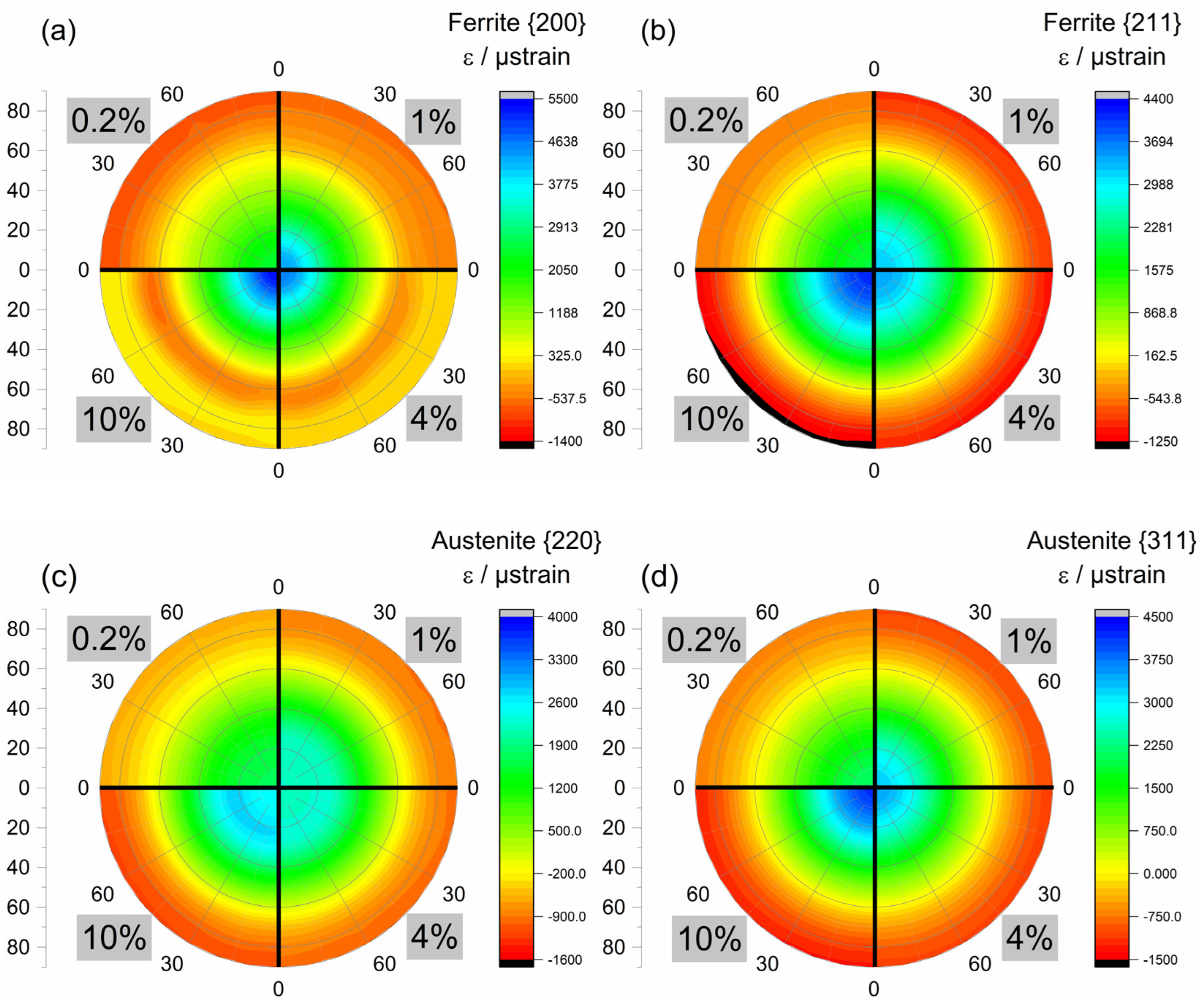
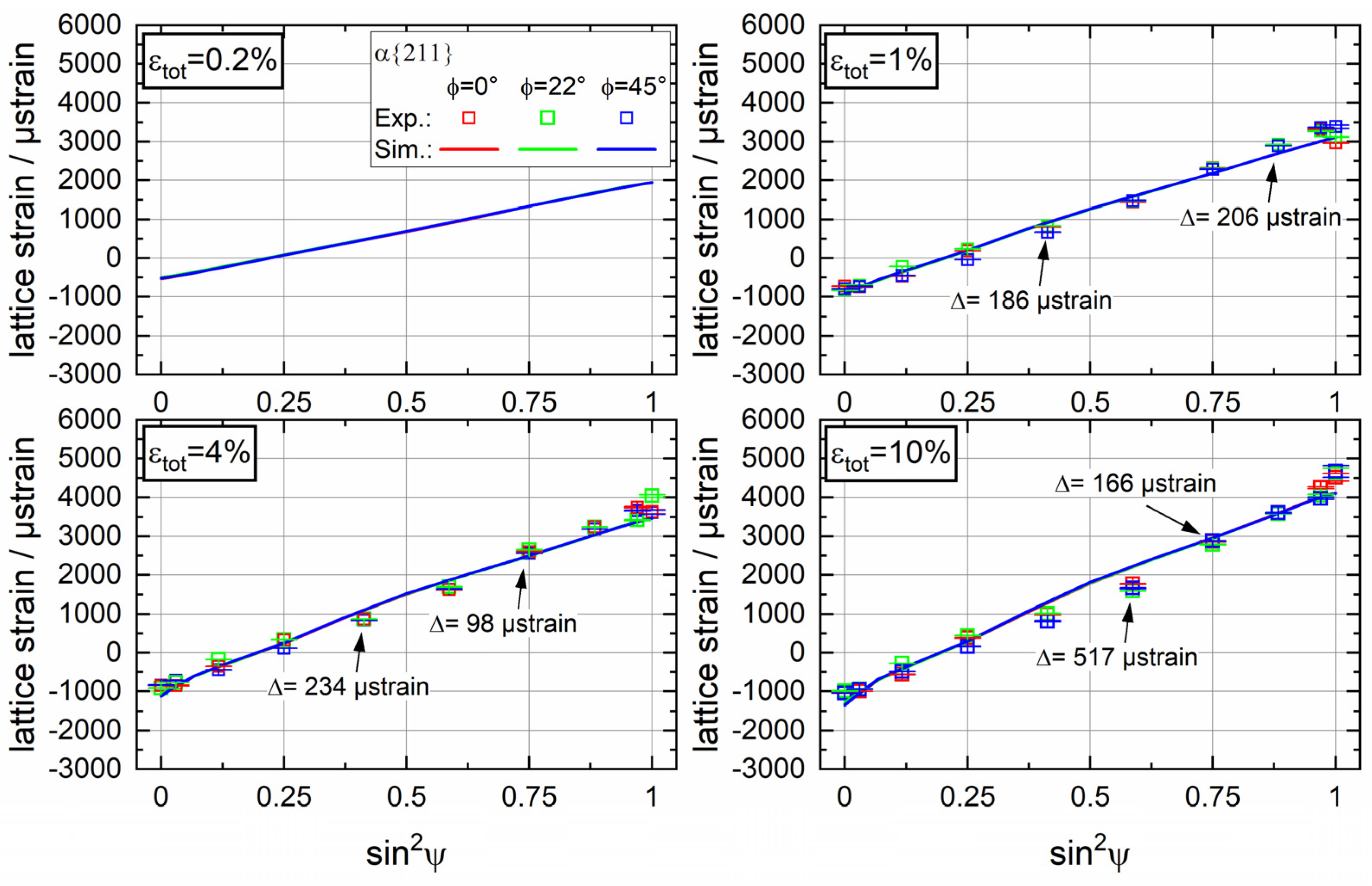
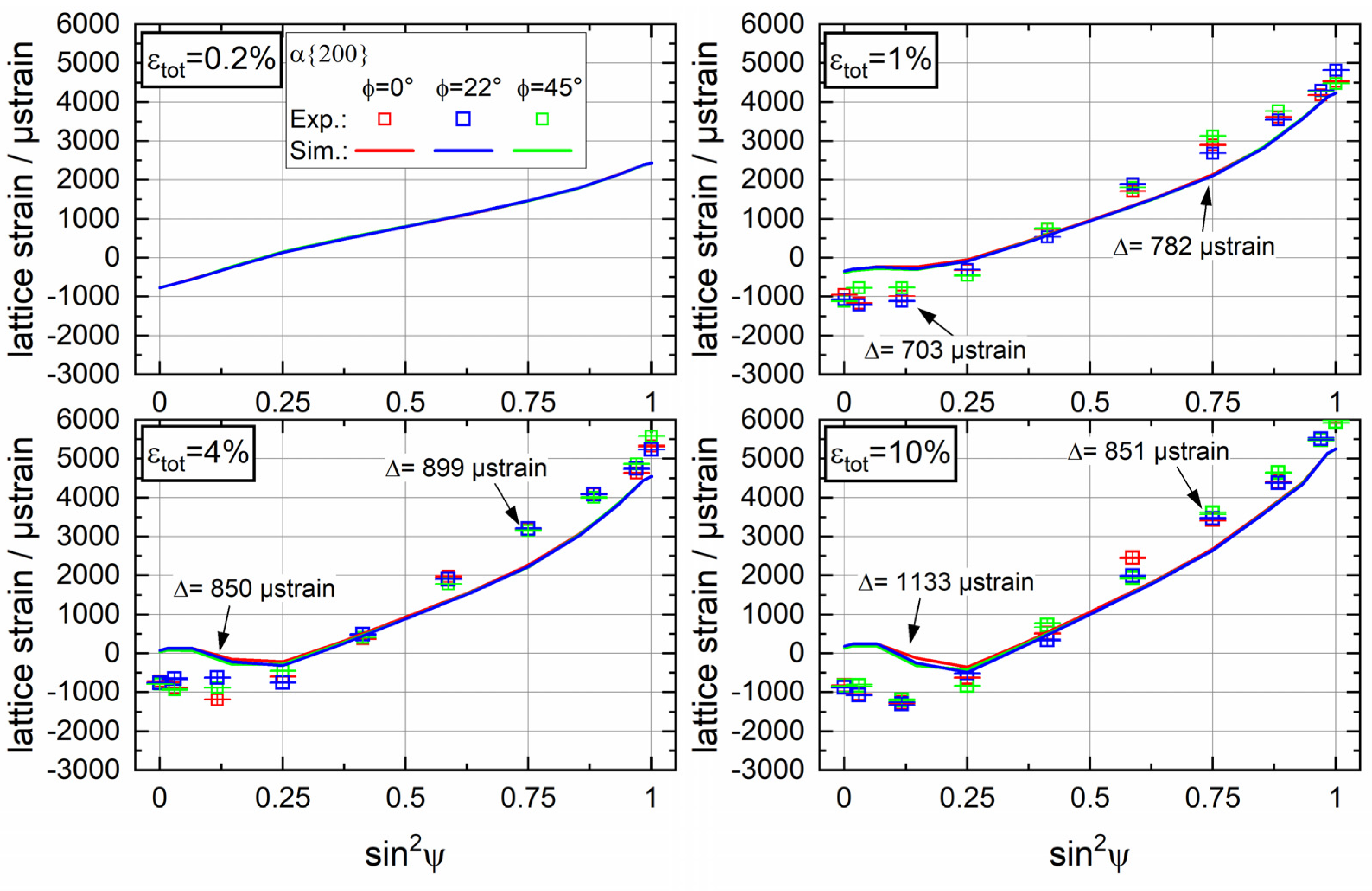

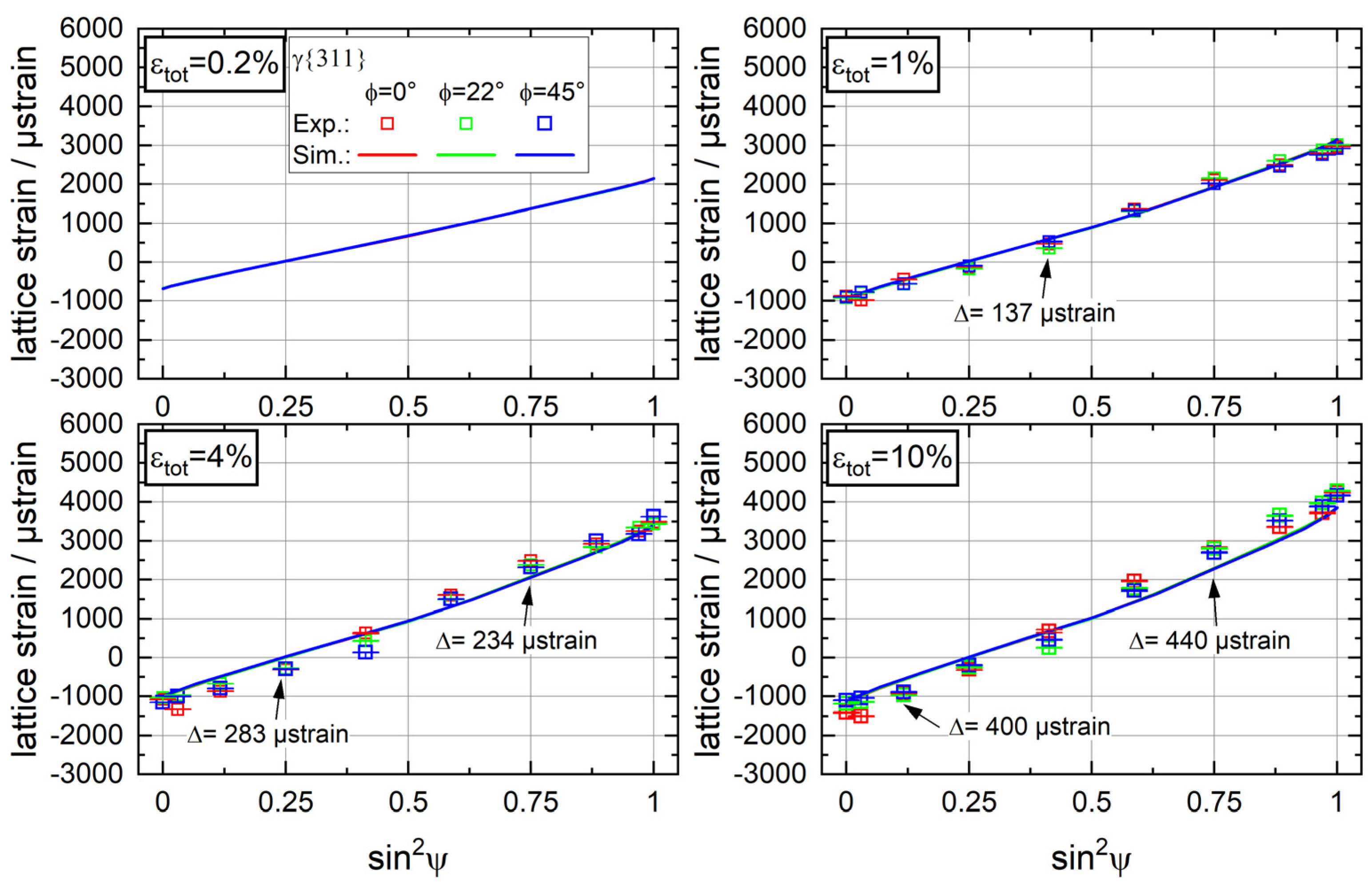
| C | Si | Mn | P | S | Cr | Mo | Ni | N |
|---|---|---|---|---|---|---|---|---|
| 0–0.03 | 0–1.0 | 0–2.0 | 0–0.035 | 0–0.015 | 21.0–23.0 | 2.5–3.5 | 4.5–6.5 | 0.1–0.22 |
| Experiment | Ferrite | Austenite | |
|---|---|---|---|
| {110}<111> | {112}<111> | <111>{110} | |
| Applied | 282 MPa | 282 MPa | 178 MPa |
| Source | Ferrite | Austenite | ||
|---|---|---|---|---|
| {110}<111> | {112}<111> | <111>{110} | ||
| Baczmański et al. [33] | 230 | 245 | 75 | |
| Pulvermacher et al. [17] | 272 | 282 | 195 | |
| Hardening parameter | Hardening parameter | |||
| Baczmański et al. [34] | 220 | 110 | 140 | 225 |
| 350 | 110 | 140 | 225 | |
| 360 | 110 | 120 | 225 | |
| 410 | 190 | 150 | 380 | |
| Dakhlaoui et al. [63] | 245 | 80 | 75 | 190 |
| Dakhlaoui et al. [35] | 220 | 120 | 140 | 200 |
| 125 | 120 | 125 | 200 | |
Disclaimer/Publisher’s Note: The statements, opinions and data contained in all publications are solely those of the individual author(s) and contributor(s) and not of MDPI and/or the editor(s). MDPI and/or the editor(s) disclaim responsibility for any injury to people or property resulting from any ideas, methods, instructions or products referred to in the content. |
© 2024 by the authors. Licensee MDPI, Basel, Switzerland. This article is an open access article distributed under the terms and conditions of the Creative Commons Attribution (CC BY) license (https://creativecommons.org/licenses/by/4.0/).
Share and Cite
Pulvermacher, S.; Loebich, F.; Prahs, A.; Liu, H.; Cabeza, S.; Pirling, T.; Hofmann, M.; Gibmeier, J. Analysis of Phase-Specific Strain Pole Figures for Duplex Steels under Elasto-Plastic Uniaxial Tension—Experiment vs. EPSC Modelling. Crystals 2024, 14, 206. https://doi.org/10.3390/cryst14030206
Pulvermacher S, Loebich F, Prahs A, Liu H, Cabeza S, Pirling T, Hofmann M, Gibmeier J. Analysis of Phase-Specific Strain Pole Figures for Duplex Steels under Elasto-Plastic Uniaxial Tension—Experiment vs. EPSC Modelling. Crystals. 2024; 14(3):206. https://doi.org/10.3390/cryst14030206
Chicago/Turabian StylePulvermacher, Samuel, Florian Loebich, Andreas Prahs, Hangning Liu, Sandra Cabeza, Thilo Pirling, Michael Hofmann, and Jens Gibmeier. 2024. "Analysis of Phase-Specific Strain Pole Figures for Duplex Steels under Elasto-Plastic Uniaxial Tension—Experiment vs. EPSC Modelling" Crystals 14, no. 3: 206. https://doi.org/10.3390/cryst14030206





